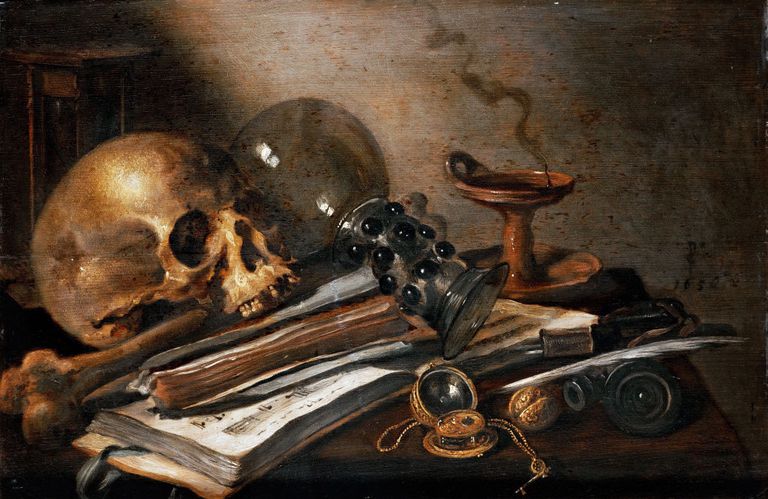
Context/Concept:
During the 17th century Dutch artwork was primarily Vanitas still life. The paintings were to serve as reminder of mortality and the consequence of giving in to vanity. The artwork become popular just after the Dutch Republic had suffered two waves of Plague in the 1620s, this meant that people were now more aware of their own mortality. At this time there was also a strong rivalry between the Catholic and Protestant branches of Christianity, both of which were promoting having a connection to God. This was also something that Vanitas aimed to symbolize by making people realize that their material possessions would not follow them to Heaven and they should not be something to value above religion.
Visual:
In this painting Willem Claesz Heda presents a perfect example of a Vanitas still life. The image shows the skull and possessions of a now dead man arranged out on a table in a clearly disorganized way. Heda would have arranged the items this way intentionally to show the chaos vanity can bring to a man’s life. During the 17th century it would not have been uncommon for people to strive for riches to better themselves and show off their wealth, however consequentially, they would become reckless and consumed by greed and power. Heda also shows off the gold compass by placing it at the head of the table in the light to represent how man can easily be temped by the promise of wealth.
Perhaps the most striking and unusual object in the painting is the skull and bones. This is obviously supposed to represent death, however, it could also be used to create shock factor for the painting’s observer. This would make this image stay with its observer allowing them to really consider the message of the painting and think about their mortality.
A third key symbol in this painting is the snuffed out candle at the back of the table. This, not only shows the age of painting as it clearly indicates that it was sometime before the invention of electricity (1800s), but also symbolizes that life can also been stuffed out.
One of Heda’s other obvious symbols is the empty goblet in the center of the image. The cup represents two things. The first being riches. A goblet would have been an item found at the dinner table of the wealthy to enjoy wine with their food as they were the only people who would have been able to afford such a well crafted item as well as the wine that would have filled it. Wine again represents wealth as the the grapes used to make it would have likely been imported from Spain or France as part of an expensive trade deal. The second important detail about the goblet is that it it empty. This is to show the reality behind the emptiness of life and to represent how our material goods have no value in the after life.
In the background of the painting a hourglass can been seen. This is to represent time running out. It suggests that our time among the living has a time limit that is constantly drawing closer to its end.
Finally, Heda has placed two books under the skull in this painting, one closed book and one open with sheet music written on it. The presence of the book is to represent pride in knowledge. It was common that wealthy men would become scholars and dedicate their time to learning. Being educated would have been sign of status and wealth as only the wealthy would have been able to afford to send their children to school. The sheet music may also represent this, however it more common for music to be used as a symbol for enjoyment, entertainment or perhaps to resemble to life coming to an end and fading away in the same way a song would.
